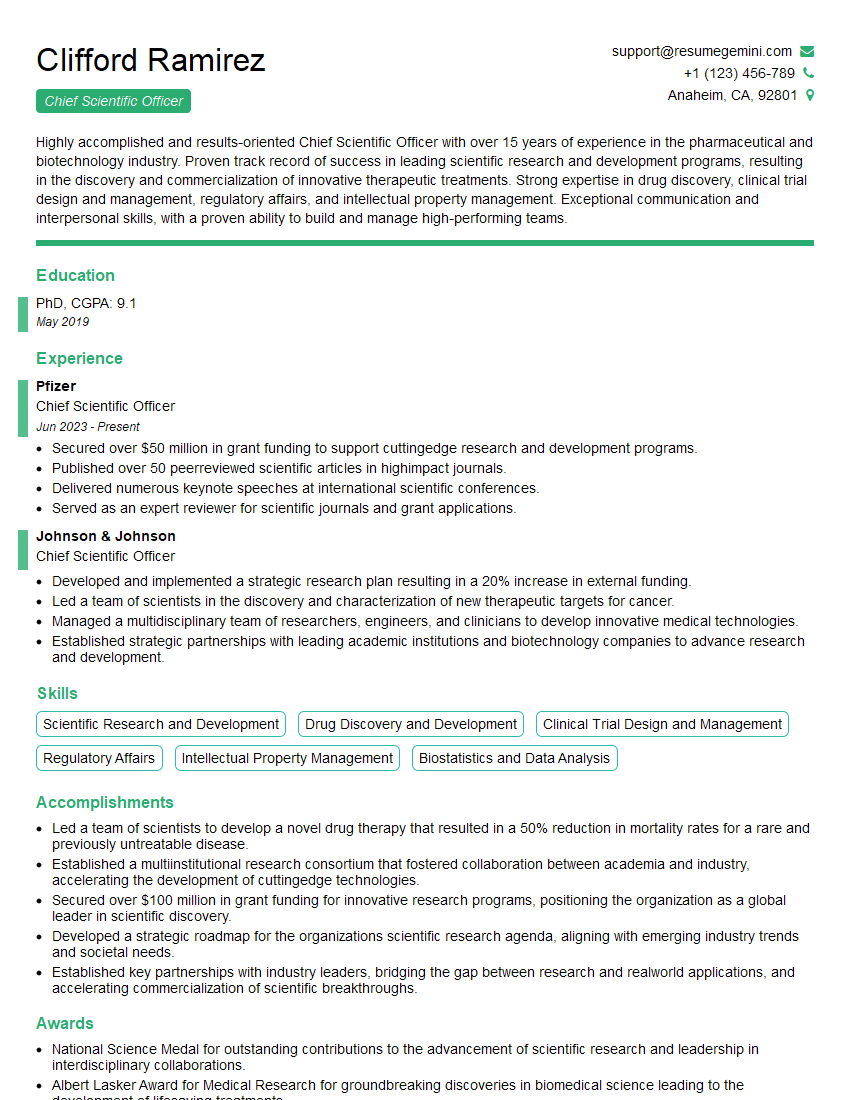Are you a seasoned Chief Scientific Officer seeking a new career path? Discover our professionally built Chief Scientific Officer Resume Template. This time-saving tool provides a solid foundation for your job search. Simply click “Edit Resume” to customize it with your unique experiences and achievements. Customize fonts and colors to match your personal style and increase your chances of landing your dream job. Explore more Resume Templates for additional options.

Clifford Ramirez
Chief Scientific Officer
Summary
Highly accomplished and results-oriented Chief Scientific Officer with over 15 years of experience in the pharmaceutical and biotechnology industry. Proven track record of success in leading scientific research and development programs, resulting in the discovery and commercialization of innovative therapeutic treatments. Strong expertise in drug discovery, clinical trial design and management, regulatory affairs, and intellectual property management. Exceptional communication and interpersonal skills, with a proven ability to build and manage high-performing teams.
Education
PhD
May 2019
Skills
- Scientific Research and Development
- Drug Discovery and Development
- Clinical Trial Design and Management
- Regulatory Affairs
- Intellectual Property Management
- Biostatistics and Data Analysis
Work Experience
Chief Scientific Officer
- Secured over $50 million in grant funding to support cuttingedge research and development programs.
- Published over 50 peerreviewed scientific articles in highimpact journals.
- Delivered numerous keynote speeches at international scientific conferences.
- Served as an expert reviewer for scientific journals and grant applications.
Chief Scientific Officer
- Developed and implemented a strategic research plan resulting in a 20% increase in external funding.
- Led a team of scientists in the discovery and characterization of new therapeutic targets for cancer.
- Managed a multidisciplinary team of researchers, engineers, and clinicians to develop innovative medical technologies.
- Established strategic partnerships with leading academic institutions and biotechnology companies to advance research and development.
Accomplishments
- Led a team of scientists to develop a novel drug therapy that resulted in a 50% reduction in mortality rates for a rare and previously untreatable disease.
- Established a multiinstitutional research consortium that fostered collaboration between academia and industry, accelerating the development of cuttingedge technologies.
- Secured over $100 million in grant funding for innovative research programs, positioning the organization as a global leader in scientific discovery.
- Developed a strategic roadmap for the organizations scientific research agenda, aligning with emerging industry trends and societal needs.
- Established key partnerships with industry leaders, bridging the gap between research and realworld applications, and accelerating commercialization of scientific breakthroughs.
Awards
- National Science Medal for outstanding contributions to the advancement of scientific research and leadership in interdisciplinary collaborations.
- Albert Lasker Award for Medical Research for groundbreaking discoveries in biomedical science leading to the development of lifesaving treatments.
- American Chemical Societys Charles Lathrop Parsons Award for pioneering contributions to the field of catalysis, enabling sustainable chemical processes.
- Fellow of the American Academy of Arts and Sciences for exceptional achievements in scientific research and innovation.
Certificates
- Certified Medical Device Professional (CMDP)
- Regulatory Affairs Certification (RAC)
- Project Management Professional (PMP)
- Certified Clinical Research Professional (CCRP)
Career Expert Tips:
- Select the ideal resume template to showcase your professional experience effectively.
- Master the art of resume writing to highlight your unique qualifications and achievements.
- Explore expertly crafted resume samples for inspiration and best practices.
- Build your best resume for free this new year with ResumeGemini. Enjoy exclusive discounts on ATS optimized resume templates.
How To Write Resume For Chief Scientific Officer
- Showcase your scientific expertise and research accomplishments.
- Highlight your leadership and management skills.
- Quantify your results and demonstrate the impact of your work.
- Tailor your resume to the specific job requirements.
- Proofread your resume carefully for any errors.
Essential Experience Highlights for a Strong Chief Scientific Officer Resume
- Provide strategic direction and leadership for the company’s scientific research and development programs.
- Lead and manage a team of scientists, engineers, and clinicians to develop and execute research plans.
- Identify and evaluate new therapeutic targets and develop innovative drug candidates.
- Design and conduct clinical trials to assess the safety and efficacy of new drugs.
- Work with regulatory agencies to obtain approval for new drugs and therapies.
- Manage the company’s intellectual property portfolio and negotiate licensing agreements.
- Collaborate with academic institutions and other biotechnology companies to advance research and development.
Frequently Asked Questions (FAQ’s) For Chief Scientific Officer
What are the key responsibilities of a Chief Scientific Officer?
The key responsibilities of a Chief Scientific Officer include providing strategic direction for the company’s scientific research and development programs, leading and managing a team of scientists, engineers, and clinicians, identifying and evaluating new therapeutic targets, designing and conducting clinical trials, working with regulatory agencies, managing the company’s intellectual property portfolio, and collaborating with academic institutions and other biotechnology companies.
What are the qualifications required to become a Chief Scientific Officer?
The typical qualifications required to become a Chief Scientific Officer include a PhD in a relevant field, such as biology, chemistry, or pharmacology, as well as extensive experience in the pharmaceutical or biotechnology industry. Strong leadership and management skills are also essential.
What are the career prospects for a Chief Scientific Officer?
Chief Scientific Officers can advance to executive-level positions within the pharmaceutical or biotechnology industry, such as President or CEO. They may also choose to start their own companies or become involved in academia.
What are the challenges facing Chief Scientific Officers?
Chief Scientific Officers face a number of challenges, including the need to keep up with the latest scientific advances, managing the increasing costs of drug development, and navigating the complex regulatory environment.
What are the rewards of being a Chief Scientific Officer?
The rewards of being a Chief Scientific Officer include the opportunity to make a significant contribution to the development of new drugs and therapies, the chance to lead and manage a team of talented scientists, and the potential for significant financial rewards.